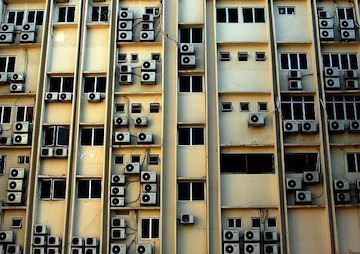High-Tech Mirror: Cool New Answer to Air Conditioning Problem?
As extremes of heat increasingly threaten to become the norm, scientists have invented a new way to reflect sunlight and beam heat away from buildings straight back into space. A building festooned with air conditioning units to cope with urban heat in Kuala Lumpur. Photo by Tino Bao via Wikimedia Commons
A building festooned with air conditioning units to cope with urban heat in Kuala Lumpur. Photo by Tino Bao via Wikimedia Commons
By Tim Radford, Climate News NetworkThis Creative Commons licensed piece first appeared at Climate News Network.
LONDON — A new material — and a new science called nanophotonics — could offer a revolutionary way to cool down the baking cities of tomorrow.
Climate scientists have repeatedly warned that greater extremes of heat will become the norm, and also that as temperatures rise to potentially dangerous levels, the energy costs of new air conditioning investment will significantly feed back into yet more global warming.
But Aaswath Raman, research associate in the Ginzton Laboratory at Stanford University, California, reports with colleagues in Nature journal that seven layers of hafnium oxide and silicon dioxide on a roof could do something very surprising.
Release warmth
They could directly reflect 97% of the sunlight away from the building, and at the same time release warmth in exactly the right infrared frequency to pass through the Earth’s atmosphere as if it wasn’t there.
In outdoor daytime tests that lasted for five hours, the temperatures in the structure below the new material fell to 4.9°C below the temperatures outside. And this effect was achieved without any use of electricity.
This new technique, which the scientists call photonic radiative cooling, could offer new ways of preserving food, chilling vaccines and saving lives in impoverished tropical regions far from any electrical supply.
“What we’ve done is create a way that should allow us to use the coldness of the universe as a heat sink during the day”
Carbon dioxide and other greenhouse gases absorb infrared light, and thus store heat from fossil fuels — but not at the wavelengths of between 8 and 13 micrometres.
Since this “transparency window” in the atmosphere can be exploited to radiate the heat directly into space, the authors say: “The cold darkness of the universe can be used as a renewable thermodynamic resource, even during the hottest hours of the day.”
The relatively new science of new materials — and the unexpected properties of old materials when made in layers only a few atoms thick — continues to surprise.
The science has already delivered photovoltaic cells that turn light directly into current, smart metals that can detect their own fractures, and also water-repelling fabrics that stay permanently clean.
The Stanford researchers started with layers of hafnium oxide — an inert material already used in semiconductors and optical coatings — and silicon dioxide, a compound also known as silica or quartz, and widely used both in microelectronics and as a food additive.
Unexpected properties
From these, they were able to fashion, on a thin silver base, an ultrathin film that carried with it two unexpected properties: it was a near-perfect reflector of visible light, and an efficient emitter for infrared light. The fabric is just 1.8 microns thick — a micron is a millionth of a metre — and could be sprayed onto structures.
There are problems yet to be solved. The first practical one is how to get the heat from inside the building into its new, super-efficient exterior coating. The second is to find ways to make the stuff in industrial quantities, and then work out how to use it most effectively. But it offers a new way of thinking about energy efficiency.
“Every object that produces heat has to dump that heat into a heat sink,” said Professor Shanhui Fan, Stanford scientist and one of the report’s authors. “What we’ve done is create a way that should allow us to use the coldness of the universe as a heat sink during the day.”
Your support matters…Independent journalism is under threat and overshadowed by heavily funded mainstream media.
You can help level the playing field. Become a member.
Your tax-deductible contribution keeps us digging beneath the headlines to give you thought-provoking, investigative reporting and analysis that unearths what's really happening- without compromise.
Give today to support our courageous, independent journalists.






You need to be a supporter to comment.
There are currently no responses to this article.
Be the first to respond.